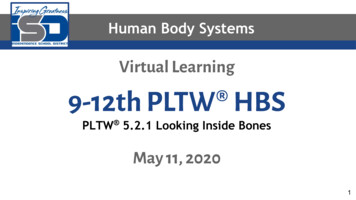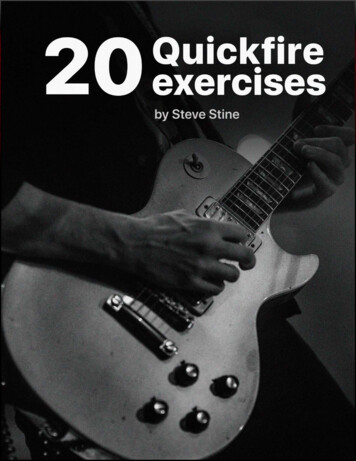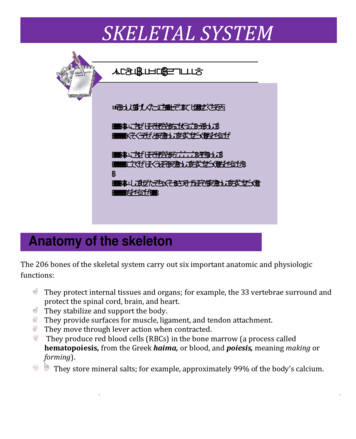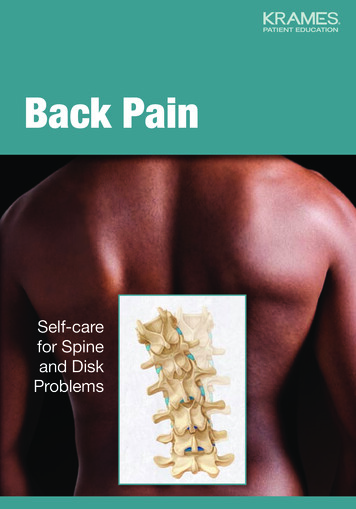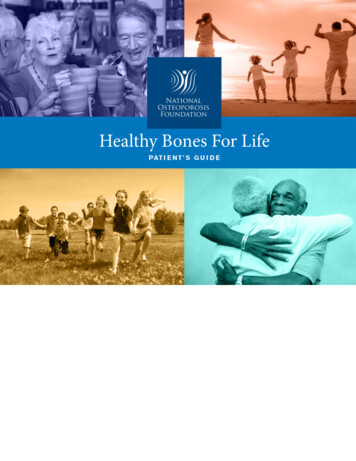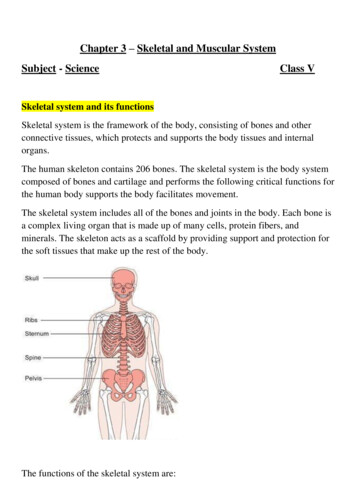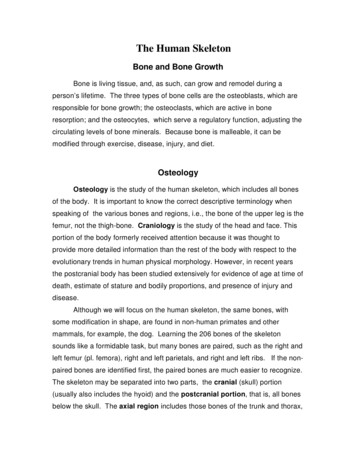
Transcription
Grades 6 to 8 Human Body SeriesBones, Muscles, and JointsKidsHealth.org/classroomTeacher’s GuideThis guide includes:The following activities will help your students learn how the bones, muscles,and joints work together, as well as how to prevent injuries from occurring.Related KidsHealth LinksArticles for Kids:Your Bones Standards Related LinksKidsHealth.org/en/kids/bones.html Discussion QuestionsMovie: Bones & Skeletal System Activities for StudentsKidsHealth.org/en/kids/ssmovie.html Reproducible MaterialsYour MusclesKidsHealth.org/en/kids/muscles.htmlMovie: Muscular The Facts About Broken BonesThis guide correlates withthe following National HealthEducation Standards:Students will: Comprehend concepts relatedto health promotion anddisease prevention to enhancehealth. Demonstrate the ability toaccess valid information andproducts and services toenhance health. Demonstrate the ability to useinterpersonal communicationskills to enhance health andavoid or reduce health risks. Demonstrate the ability touse decision-making skills toenhance health. Demonstrate the ability topractice health-enhancingbehaviors and avoid or reducehealth ins and Sprains Are a icles for Teens:Bones, Muscles, and s.htmlBroken ling With Broken tmlStrains and mlStrength itamin DTeensHealth.org/en/teens/vitamind.htmlDiscussion QuestionsNote: The following questions are written in language appropriate for sharing withyour students.National Health /standards/index.htm1.The adult human body has 206 bones, but a baby’s body has about 300 bones. Whyis there such a difference? What happens to these bones as you grow up?2.Make a list of ways that your bones protect parts of your body.3.Bones rely on the muscles and joints to move. How do they all work together? 2017 The Nemours Foundation/KidsHealth. Reproduction permitted for individual classroom use.
Grades 6 to 8 Human Body SeriesBones, Muscles, and JointsActivities for StudentsNote: The following activities are written in language appropriate for sharing with your students.Dem BonesObjective:Students will: Identify the major bones in the bodyMaterials: Computer with Internet accessArt supplies (markers, pens, or pencils; scissors; paper and tape or glue)“Dem Bones” handoutClass Time:1½ hoursActivity:Cut out the bones on the “Dem Bones” handout, and reconstruct correctly as a skeleton on a piece of paper usingtape or glue. Then label these ullsternumtibiaulnavertebraFinally, circle one ball-and-socket joint and one hinge joint.Extension:The famous gospel song “Dry Bones” describes how the different bones in the body fit together (“The foot boneconnected to the leg bone,” and so on.) It’s your turn to create a song, poem, or verse about the body — this timeabout the muscles and joints and how they help the bones move. Using catchy rhymes can help you remember thewords. 2017 The Nemours Foundation/KidsHealth. Reproduction permitted for individual classroom use.
Grades 6 to 8 Human Body SeriesBones, Muscles, and JointsGive Me a Break!Objectives:Students will: Identify injuries that can occur to bones, muscles, and joints Determine how to prevent these injuries Discover what to do if an injury occursMaterials: Computer with Internet accessPen and lined paperClass Time:1½ hoursActivity:Lots of things kids and teens do can cause bones to break, muscles to strain, and ligaments to sprain. But there areways to help prevent these injuries. Using the articles at KidsHealth.org, write an informational flyer offering tips tohelp your friends avoid these injuries. Be sure to include this information: The kinds of activities that can result in injured bones, muscles, or jointsThe kinds of injuries that can occurPrecautions to take to prevent these injuriesWhat to do if a bone is broken or a muscle is pulledExtensions:1.Create a video for young kids showing them what to expect if they need to get a cast or splint.2.Your friend just fell off his bike and is clutching his arm. You think it might be broken. How can you help him?Reproducible MaterialsHandout: Dem s handout1.pdfHandout for Teachers: Dem Bones Answer KeyKidsHealth.org/classroom/6to8/body/parts/bones handout2.pdfQuiz: Bones, Muscles, es quiz.pdfAnswer Key: Bones, Muscles, es quiz answers.pdfKidsHealth.org is devoted to providing the latest children’s health information. The site, which is widelyrecommended by educators, libraries, and school associations, has received the “Teachers’ Choice Awardfor the Family” and the prestigious Pirelli Award for “Best Educational Media for Students.” KidsHealth comesfrom the nonprofit Nemours Foundation. Check out www.KidsHealth.org to see the latest additions! 2017 The Nemours Foundation/KidsHealth. Reproduction permitted for individual classroom use.
Human Body SeriesBones, Muscles, and JointsDem BonesInstructions: Cut out the bones and use them to create a puzzle of the human skeleton. Label the major bones and brieflydescribe what they do. 2017 The Nemours Foundation/KidsHealth. Reproduction permitted for individual classroom use.Skull, vertebra,
Human Body SeriesBones, Muscles, and JointsDem Bones Answer KeySkullParieto-temporal(fixed joint)VertebraShoulder(ball andsocket emurKnee(hinge joint)TibiaFibulaAnkle 2017 The Nemours Foundation/KidsHealth. Reproduction permitted for individual classroom use.
Personal Health SeriesBones, Muscles, and JointsName:Date:QuizInstructions: Answer each question.1.Adults have this many bones and muscles, respectively:a) 198, more than 400b) 206, more than 600c) 300, more than 1,000d) Trick question! Each person has a different number of bones and muscles.2.The ribs protect the3.Underline the two main types of joints:a) Ball and socket jointb) Bend jointc) Hinge jointd) Squeeze jointe) Stretch joint4.True or false: It’s easy to flex your smooth muscles.5.True or false: Skeletal muscles are attached to bones by tendons.6.True or false: The gluteus maximus is made up of cardiac muscle.7.True or false: The worst thing for a broken bone is to move it.8.9.hold bones together at joints.RICE, the acronym that reminds you how to help an injury, stands for:a) Relax, Injury, Cold, Eatb) Rejuvenate, Inhibit, Cast, Emergencyc) Rest, Ice, Compression, Elevationd) Rice, Ice, Concise, Entice10. Name a vitamin and a mineral that help keep bones (and teeth) strong:a)b) 2017 The Nemours Foundation/KidsHealth. Reproduction permitted for individual classroom use.
Personal Health SeriesBones, Muscles, and JointsQuiz Answer Key1.Adults have this many bones and muscles, respectively:a) 198, more than 400b) 206, more than 600c) 300, more than 1,000d) Trick question! Each person has a different number of bones and muscles.2.The ribs protect the (any one of the following: heart, lungs, liver).3.Underline the two main types of joints:a) Ball and socket jointb) Bend jointc) Hinge jointd) Squeeze jointe) Stretch joint4.True or false: It’s easy to flex your smooth muscles.5.True or false: Skeletal muscles are attached to bones by tendons.6.True or false: The gluteus maximus is made up of cardiac muscle.7.True or false: The worst thing for a broken bone is to move it.8.9.Ligaments hold bones together at joints.RICE, the acronym that reminds you how to help an injury, stands for:a) Relax, Injury, Cold, Eatb) Rejuvenate, Inhibit, Cast, Emergencyc) Rest, Ice, Compression, Elevationd) Rice, Ice, Concise, Entice10. Name a vitamin and a mineral that help keep bones (and teeth) strong:a) vitamin Db) calcium 2017 The Nemours Foundation/KidsHealth. Reproduction permitted for individual classroom use.
Grades 6 to 8 Human Body Series. Bones, Muscles, and Joints. The following activities will help your students learn how the bones, muscles, and joints work together, as well as how to prevent injuries from occurring. Related KidsHealth Links . Articles for Kids: Articles for Teens: Discussion Questions
